Food As Medicine

What Do Specific Foods Do?
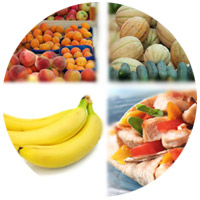 Let thy food be thy medicine and thy medicine be thy food.
Let thy food be thy medicine and thy medicine be thy food.
- Hippocrates (460-377 BC)
You need only to view the movie Super Size Me to understand how foods impact the body. In the movie, the director Morgan Spurlock chronicles the adverse health outcomes he experienced from eating nothing but fast food for several weeks. He not only gained weight, he experienced alarming metabolic changes that put him at risk for heart disease, diabetes, and hypertension.
Spurlock was eating foods that gave his body the wrong messages. For instance, in just a few weeks, the excessive amounts of saturated and trans-fatty acids in the fast food diet led to inflammation and higher blood cholesterol. In addition, the fast food diet failed to provide the information necessary for normal metabolic function, which also contributed to the health changes.
Morgan Spurlock is an example of what happens when food is broken down into nutrients, which then impact the metabolic programming of cells and the homeostasis (balance) in the body. There is a growing realization that the effects of nutrition on health and disease cannot be understood without a profound understanding of how nutrients act at this molecular level (Nature Reviews Genetics, 2003).
What's in this section?
This section looks at how food influences the maintenance of health and the prevention, alleviation, or cure of disease. Which, by the way, is the definition of medicine. With knowledge, we can allow food to be our medicine and medicine to be our food, as Hippocrates recommended so long ago.
After a quick consideration of the role of genes, we look at the role of some categories of foods (click on a link if you want to go directly to that food category):
How do nutrients interact with genes?
 One of the breakthrough concepts from the Human Genome Project is that "genes in and of themselves do not create disease. Only when they are plunged into a harmful environment unique to the individual do they create the outcome of disease."
One of the breakthrough concepts from the Human Genome Project is that "genes in and of themselves do not create disease. Only when they are plunged into a harmful environment unique to the individual do they create the outcome of disease."
An advancing area of study called Nutrigenomics looks at how different foods may interact with specific genes to modify the risk of common chronic diseases such as Type II diabetes, obesity, heart disease, stroke and certain cancers.
Nutrigenomics also seeks to identify the molecules in the diet that affect health by altering the expression of genes. (For example, by triggering the genes that start the onset of Type II diabetes.)
For example, one study showed that participants who consumed a diet of whole rye (low-insulin-response) experienced changes in their gene expression that reduced their risk of developing diabetes. Participants who consumed an oat-wheat-potato (high insulin response) diet experienced the opposite-a change in their gene expression that increased their risk.
As an editorial published in the American Journal of Clinical Nutrition (2007) noted in response to this study-we are spending millions to find drugs that can impact our production of hormones such as insulin, when there might already be a simple dietary strategy. The editorial concludes, "The results of the present study emphasize the age old wisdom to use food as medicine.
We cannot change our genes, but we can change the environment which impacts how our genes manifest. One important component of this environment is food.
What is the role of fruits and vegetables?
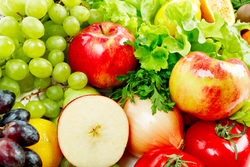 While the health-related benefits of a diet rich in fruits and vegetables is known to most, the scientific literature in the last nine to ten years has increasingly pointed out the influence of these food groups on a variety of diseases. For example, several studies, such as one recently published in the American Journal of Clinical Nutrition, show that the higher the consumption of fruit and vegetables, the lower the incidence of cardiovascular disease including stroke.
While the health-related benefits of a diet rich in fruits and vegetables is known to most, the scientific literature in the last nine to ten years has increasingly pointed out the influence of these food groups on a variety of diseases. For example, several studies, such as one recently published in the American Journal of Clinical Nutrition, show that the higher the consumption of fruit and vegetables, the lower the incidence of cardiovascular disease including stroke.
The following is a list of resources that fruits and vegetables provide to the body:
- Vitamins and minerals (including antioxidants, such as vitamin A, C, E and selium). Vitamins and minerals are found in all foods, but fruits and vegetables are a particularly good source for some vitamins and minerals. Vitamins and minerals play a vital role in most metabolic processes. Complex interactions make it essential that the status of all vitamins and minerals be kept at optimal levels.
- Phytonutrients are considered anti-inflammatory and offer many health benefits outlined below.
- Fiber, which assists digestion, slows carbohydrate absorption, and promotes satiety. (See the whole grains section for more information on the benefits of fiber.)
Example: An apple a day
Apples contain a rich source of a variety of phytonutrients. Epidemiological studies have linked the consumption of apples with reduced risk of cardiovascular disease, asthma, diabetes, and some cancers. Apples have been found to have very strong anti-oxidant activity, inhibit cancer cell proliferation, and decrease lipid oxidation and lower cholesterol (Nutrition Journal, 2004).
Examples of vitamins and minerals
Vitamin C
- Prevents cell damage from free radicals
- Boosts iron absorption
- Enhances immune function, which increases resistance to disease
- Promotes healthy gums and wound healing
- Resolves bruising and recurrent infections
Sources of vitamin C: citrus fruits, tomatoes, green leafy vegetables, parsley, cabbage, asparagus, avocados, cantaloupe, currants, mangos, kiwi, papaya, peppers, pineapple, and strawberries.
Vitamin A
- Prevents cell damage from free radicals
- Maintains the tissue of the skin and gastrointestinal and respiratory tracts >
- Enhances immune function natural killer cells and T-cells
- Heightens resistance to infection
Sources of Vitamin A: carrots, apricots, sweet potatoes, yellow squash, pumpkin, watercress, Swiss chard, greens, eggs, fish liver oil, milk, and cheese.
Folic acid, Vitamin B-6 and B-12
- Vital for central nervous function
- Necessary for immune system function
- Needed for the metabolism of amino acids and the synthesis of proteins>
- Used in managing elevated homocysteine (an independent risk factor for heart disease)
Sources of B-vitamins: meat, fish, chicken, seafood, dark green leafy vegetables, legumes, whole grains, nuts, and seeds.
Phytonutrients
What phytonutrients do
In addition to vitamins and minerals, plants contain compounds called phytonutrients (sometimes referred to as phytochemicals). Essentially, these compounds are the plants' protection. A plant cannot fight or flee, so it is equipped with "phyto" or plant nutrients that defend against disease, blight, radiation, weather, insects and anything else that may threaten the plant's survival.
When we eat the plants, we not only benefit from the vitamin and mineral content of the plant, but from the protection these phytonutreints provide. Phytonutrients are considered anti-inflammatory and have been shown to possess anti-cancer properties, repair DNA damage, aid detoxification, enhance immunity, and influence insulin glucose balance.
How do you know if you are getting enough?
Hundreds of phytonutrients have been discovered thus far. Because fruits and vegetables contain different amounts of these beneficial compounds, it is best to eat a variety of plants.
Phytonutreint content is categorized by color (dark green, light green, red, orange, and purple.) If you get at least one from each of these color groups daily, you will not only be getting a variety of beneficial phytonutrients, but meeting the recommended minimum of 5 to 13 servings of fruits or vegetables a day. (Note: while color indicates the predominant phytonutrient content, most fruits and vegetables contain multiple phytonutrients.)
Sources
- Cabbage, Brussels sprouts, broccoli, kale, cauliflower and turnips all contain the phytonutrient indole-3-carbinol.
- Oranges, tangerines, lemons, and limes all contain a flavonoid called limonene.>
- Grapes, apples, cherries, blueberries, and raspberries contain anthocyanins>
- Onions and garlic contain the phytonutrient quercitin.
- Tomatoes, red pepper, watermelon and radishes all contain lycopene.
- Peaches, carrots, apricots, pumpkin, squash; the phytonutrient carotinoids
- Swiss chard, kale, parsley contain the phytonutrient lutein
What is the bottom line about fruits and vegetables?
The bottom line is: include from 5 to 13 servings of a variety of fruits and vegetables daily. A serving is one piece of fruit, ½ cup of vegetable, 1 cup of salad greens, or ½ c of juice (choose juices without added sugar or corn syrup).
For more information, go to the Linus Pauling Institute, which gives scientific information regarding the role of vitamins, minerals, and other nutrients and phytonutrients.
What is the role of whole grains?
 Whole grains offer a number of important health benefits, including:
Whole grains offer a number of important health benefits, including:
- Regulate blood sugar (because complex carbohydrates are metabolized more slowly)
- Aid digestion by producing good bacteria in the gut
- Control appetite (because the fiber in the grains signals satiety-the sense of being full)
- Reduce cholesterol
- Remove toxins (because fiber binds to toxins in the gut and removes them during elimination
- Improve digestive system function
- Synthesize neurotransmitters (the chemical messengers made by the body, such as serotonin for sleep and mood)
Examples
The relationship between changes in intake of dietary fiber and whole grain and changes in weight among middle-aged women was documented in a study published in American Journal of Clinical Nutrition (2003). Researchers found women who consumed more whole grains consistently weighed less than did women who consumed less whole grains. Women who had the highest intake of dietary fiber had a 49 percent lower risk of weight gain. Unlike the advice to limit carbohydrates by some popular diets, this data indicates the importance of whole grain products to aid weight control.
Results from the Physicians Health Study I published in the Archives of Internal Medicine (2007), showed that whole grain intake (but not refined grain intake) was associated with lower risk for heart failure. Researchers postulate that is related to the phytonutrients that influence physiological function.
Sources of beneficial whole grain
- Whole Wheat
- Whole Rye
- Oats
- Brown Rice
- Wild Rice
- Spelt
- Amaranth
- Buckwheat
- Buckwheat Groats
- Bulgur
- Kamut
- Millet
- Cornmeal
- Barley
- Wheat Germ
- Quinoa
Recommendations
Increase whole grains and limit refined grain products.
When choosing grain products, be sure it says "whole grain" on the ingredients list. If it doesn't, it isn't whole grain.
What is the role of protein?
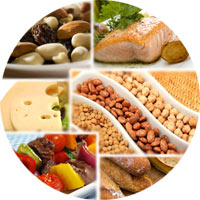 Meats, fish, and beans are key sources of protein in our diet. Less is known about protein and its relationship to health and disease than fats or carbohydrates. It is known that protein is abundant in the body and regulates multiple messengers that keep us functioning. Protein provides the body with amino acids, which we need daily because the body does not store them. Proteins provide information to help the body do the following:
Meats, fish, and beans are key sources of protein in our diet. Less is known about protein and its relationship to health and disease than fats or carbohydrates. It is known that protein is abundant in the body and regulates multiple messengers that keep us functioning. Protein provides the body with amino acids, which we need daily because the body does not store them. Proteins provide information to help the body do the following:
- Regulate blood sugar and insulin balance
- Produce hormones that regulate mood and sleep
- Detoxify (during the second phase of detoxification in the liver, protein attaches to waste molecules and escorts them out of the body)
- Make connective tissue for skin, cartilage and bone
- Build muscle
- Promote wound healing
- Aid adrenal and thyroid function
- Produce and maintain a feeling of satiety (feeling full)
Examples
Soy has been found to have anti-inflammatory activity in the body. It is believed that part of this activity is due to a component of soy called genistein. A study published in the Journal of Nutritional Biochemistry (2007) looked at genistein (derived from soy) for its potential to reduce pro-inflammatory molecules in human cartilage cells. Results indicated genistein was able to suppress COX2, which are pro-inflammatory molecules, but did not affect COX1, which is necessary for cellular housekeeping functions. In other words, it suppressed the bad messenger molecules, but left the good ones. These findings may impact the use of soy and its relationship to the development and treatment of inflammatory conditions such as osteoarthritis.
Sources
- Fish, poultry, meats
- Eggs
- Goat's milk and cheeses
- Cow's milk and cheese
- Yogurt
- Tofu and other soy foods
- Soy based meat substitutes
- Peanut and other nut butters
- All nuts and seeds
- Dried and canned beans, peas, lentils
- Whole grain
Recommendations
- Get a good mix of proteins, both animal (unless vegetarian) and plant. Eating a variety of proteins will ensure that you get all of the amino acids (building blocks of protein) you need.
- If you eat meat, include the leanest cuts, and try to buy 100% grass-fed meats because they are more anti-inflammatory than corn-fed.
- If you use dairy products, choose skim or low-fat versions for healthier choices.
- Include beans, soy, nuts, and whole grains, which offer protein without much saturated fat and with plenty of healthful fiber and micronutrients.
What is the role of fats and oils?
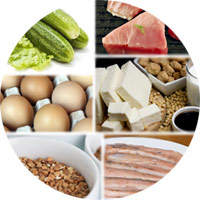 The prevalence of low-fat diets in our culture leads many of us to assume that eating any fat is bad, but our bodies require some fat to be healthy. As scientific and public opinion of fats is slowly shifting, the emerging consensus is that eating the right kind of fats is important to health and the prevention of disease. Fats provide information to help the body do the following:
The prevalence of low-fat diets in our culture leads many of us to assume that eating any fat is bad, but our bodies require some fat to be healthy. As scientific and public opinion of fats is slowly shifting, the emerging consensus is that eating the right kind of fats is important to health and the prevention of disease. Fats provide information to help the body do the following:
- Provide insulation for the organs
- Transport fat-soluble vitamins (A, D, E, K)
- Provide materials critical to the integrity of cellular membranes
- Lubricate mucous membranes and skin
- Provide materials used to make hormones
- Utilize glucose more effectively
- Contribute to healthy joints
- Enjoy efficient gut health
- Facilitate immune system function
- Increase or decrease inflammation (depending on type of fat). Generally we want to eat fats that decrease inflammation, such as oils from plants, nuts, and seeds and fats from fish whose diet is made up of algae (these all contain a predominance of omega 3 fatty acids).
Issues of mercury contamination
In Eat Drink and be Healthy, Walter Willett discusses issues of contamination in certain fish. He says that farm-raised fish are less likely to be contaminated by mercury and other toxins, but they may not be as high in omega 3 fatty acids, depending on what they have been fed. "If the fish are fed other fish or algae they will have a higher content of omega 3 fatty acids, but if they are fed wheat and corn they won't contain much." Willett recommends monitoring farm fishing by requiring a label that gives omega-3 content of farm-raised fish. To help choose a fish with lower mercury content, go to the US Environmental Protection Agency fish advisory.
Examples
A study in the Journal of Nutrition (2003) found the type, rather than the amount, of fat consumed to be the most important factor impacting the cholesterol levels of women.
Researchers found total cholesterol and LDL cholesterol were lower and the LDL/HDL ratio more favorable in women who consumed a high poly- and monosaturated fatty acid diet (with olive, canola, and fish oils), as compared to two other diets (a high saturated fat and a low-fat diet). These results indicate that changing the quality of the dietary fatty acids may be more important than restricting the percentage of total or saturated fat energy.
Sources
- Flaxseed
- Salmon
- Mackerel
- Sardines
- Herring
- Anchovies
- Lake trout
- Tuna
- Pumpkins seeds
- Cereal grasses, such as wheat or barley grass
- Dark green vegetables
- Soybeans
- Tofu
- Walnuts, almonds, sunflower seeds
- Omega-3 enriched eggs
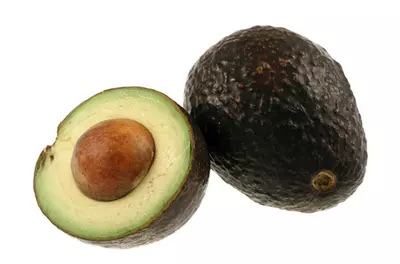
Recommendations
Enjoy beneficial fats. Get the majority of your fats from plants and fish and minimize saturated animal fats.
The Linus Pauling Institute website gives scientific information regarding the role of vitamins, mineral, other nutrients and phytonutrients.
Boyer J, Liu RH. (2004). Apple phytochemicals and their health benefits. Nutrition Journal.
Galarraga, B. et al. (2008). Cod liver oil 9n-3fattyacids as a non-steroidal anti-inflammatory drug sparing agent in rheumatoid arthritis. Rheumatology.
Hooshmand, S. et al. (2007). Genistein reduces the production of proinflammtory molecules in human chondrocytes. Journal of Nutritional Biochemistr: 18(9) 609-614.
Liu, S., et al. (2003). Relationship between changes in intakes of dietary fiber and grain products and changes in weight and developments of obesity among middle-aged women. American Journal of Clinical Nutrition, 78(5), 920-927.
Mueller M, Kersten S. (2003). Nutrigenomics: goals and strategies. Nature Reviews Genetics. 4:315-322.
Muller H, Lindman AS, Brantsaeter AL, Pederson, J. (2003). The serum LDL/HDL cholesterol ratio is influenced more favorably by exchanging saturated with unsaturated fat than by reducing saturated fat in the diet of woman. Journal of Nutrition. 133(1) 78-83.
Padayatty SJ, Levine M. (2008) Fruits and vegetables: think variety, go ahead, eat. American Journal of Clinical Nutrition, 78 (1): 5-7.
Petteri, K, et al. (2007). "Dietary carbohydrate modification induces alterations in gene expression in abdominal subcutaneous adipose tissue in persons with the metabolic syndrome: the FUNGENUT Study." American Journal of Clinical Nutrition 85 (5): 1417-1427.
Salsberg SL, Ludwig DS. (2007). Putting your genes on a diet: the molecular effects of carbohydrate. American Journal of Clinical Nutrition, 85 (5): 1169-1170.
Wang L, et al. (2007) Breakfast cereals and risk of heart failure in the Physicians health Study I. Archives of Internal Medicine, 167 (19) 472-479.
Willett W. (2001) Eat Drink and be Healthy. Simon & Schuster. New York.

